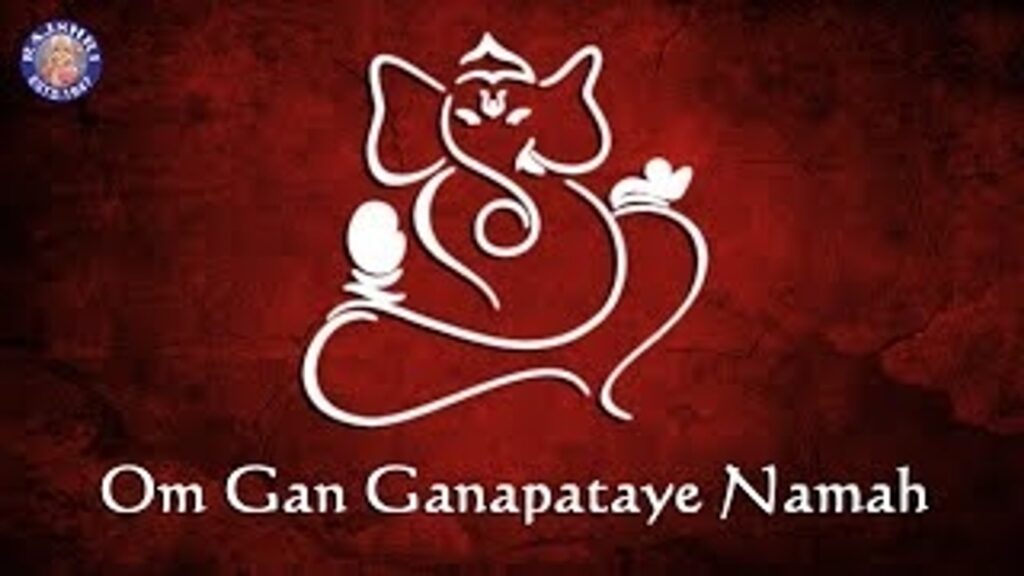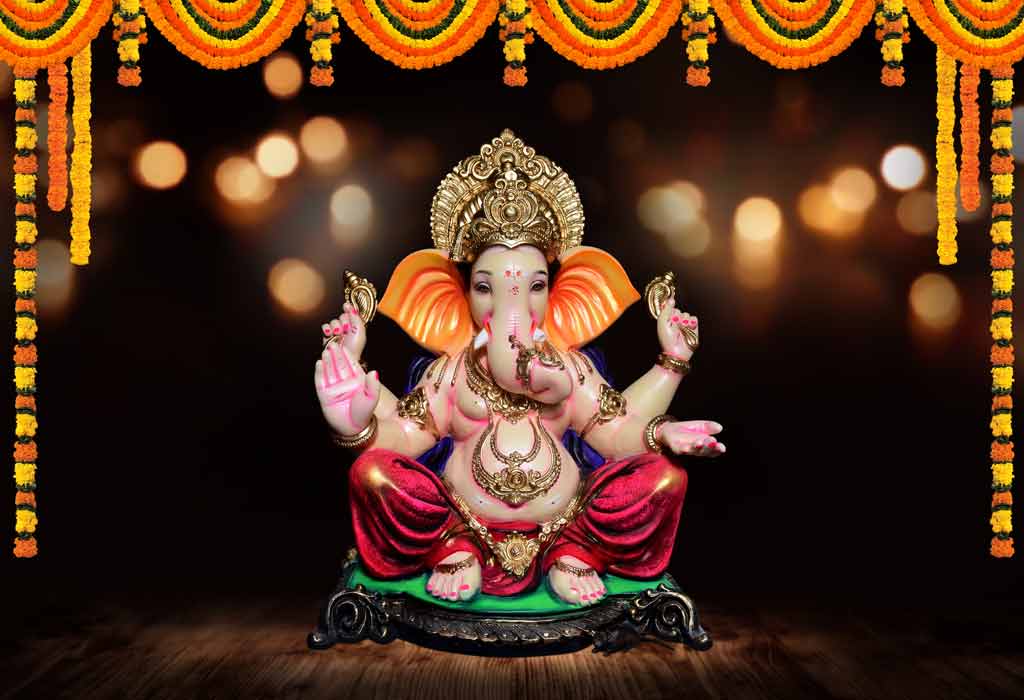In Hindu spiritual practices, mantra chanting occupies a unique and revered space. One of the most potent and universally recognized among these mantras is the Ganesha mantra – “Om Gan Ganapataye Namah“. It is an ancient Sanskrit invocation that honors Lord Ganesha, the deity with the head of an elephant and a body of a human, widely worshipped as the remover of obstacles, the patron of wisdom and learning, and the harbinger of success and prosperity.
“Om Gan Ganapataye Namah” is not merely a set of words but a powerful spiritual tool, a vibrational blueprint that resonates with the divine frequency of Lord Ganesha. The mantra holds within its sounds and syllables the essence of Ganesha’s divine qualities, serving as a sacred conduit for connecting with this deity’s benevolent grace.
Meaning of “Om Gan Ganapataye Namah”
The Sanskrit mantra “Om Gan Ganapataye Namah,” prominently employed in Hindu rituals and practices, exhibits profound theological significance. As an invocation to Lord Ganesha, it embodies an act of profound respect and supplication to the deity revered as the remover of obstacles and the harbinger of wisdom and prosperity.
Each component of the mantra “Om Gan Ganapataye Namah” carries a distinct theological and linguistic connotation:
- “Om”: This sacred monosyllable is foundational to most Hindu mantras. Regarded as the primordial sound of the universe, “Om” represents the Infinite and the final truth of the universe beyond boundaries of time and space.
- “Gan”: This syllable is linked to Ganesha and is repeated twice for emphasis and to intensify the power of the mantra.
- “Ganapataye”: An epithet for Ganesha, this term is derived from ‘Gana,’ signifying group or multitude, and ‘Pati,’ translating to leader or lord. As ‘Ganapataye,’ Ganesha is identified as the lord of multitudes, a supreme being commanding the cosmos’ forces.
- “Namah”: Of Sanskrit origin, “Namah” is a term of respect and reverence, signifying bowing, homage, or salutation.
Collectively, the mantra “Om Gan Ganapataye Namah” translates to “I bow to the Lord of multitudes (Ganesha).” Chanting this mantra represents a spiritual practice whereby devotees seek Ganesha’s divine intervention in removing obstacles and ensuring the successful completion of their endeavors. Regularly invoked at the beginning of religious ceremonies, scholarly readings, and new undertakings, it symbolizes a plea for the smooth progression of events under the protective oversight of Lord Ganesha.
Benefits of Chanting Lord Ganesha mantra
In Hinduism, the ritualistic practice of mantra chanting is more than just an act of religious devotion; it is a transformative spiritual discipline that has far-reaching impacts on the practitioner’s mental, emotional, and spiritual well-being. Chanting the “Om Gan Ganapataye Namah” mantra is particularly beneficial due to the divine attributes associated with Lord Ganesha.
- Spiritual enhancement: Chanting the Ganesha mantra with focused intention fosters a deeper connection with the divine, enhancing the spiritual awareness and consciousness of the practitioner. The vibrational energy produced by the mantra resonates with the divine frequency of Lord Ganesha, inviting divine blessings and grace into the practitioner’s life.
- Obstacle removal: As Lord Ganesha is revered as the remover of obstacles, regular chanting of this mantra aids in mitigating hindrances, challenges, and blockages in both material and spiritual pursuits. This is particularly helpful when commencing new ventures, where the practitioner seeks to ensure a smooth and successful progression.
- Cognitive benefits: The discipline of mantra chanting necessitates focus and concentration, contributing to enhanced cognitive abilities over time. Furthermore, the specific association of Lord Ganesha with wisdom and learning makes this practice beneficial for those engaged in academic pursuits or intellectual work.
- Psychological well-being: Mantra chanting often induces a state of tranquillity and peace, mitigating stress, and promoting emotional well-being. The rhythmic repetition of the mantra can serve as a form of mindfulness meditation, encouraging mental clarity and emotional stability.
- Harmonization of energy: As per the principles of Hindu metaphysics, the sound vibrations produced by mantra chanting can harmonize the practitioner’s energy, aligning it with the divine vibrations. This promotes overall well-being, balance, and positivity.
- Invitation of prosperity: As Lord Ganesha is also associated with prosperity and good fortune, regular chanting of this mantra invites material and spiritual abundance, leading to fulfillment and contentment.
In conclusion, the practice of chanting “Om Gan Ganapataye Namah” is a potent spiritual discipline that harnesses the power of sound, intention, and divine connection, offering profound benefits that extend beyond the realm of religious observance into the domains of personal growth, well-being and life success.
The Origin of Lord Ganesha mantra
The Sanskrit mantra “Om Gan Ganapataye Namah” has a deep-rooted historical and spiritual significance in Hinduism. This mantra is primarily dedicated to Lord Ganesha, one of the most celebrated deities in the Hindu pantheon. This mantra originates from the Ganapati Atharvasirsha, an ancient Sanskrit text, forming part of the Upanishadic literature that is foundational to the philosophical thought of Hinduism.
The Ganapati Atharvasirsha, alternatively known as the Ganapati Upanishad, forms a significant component of the corpus of Upanishadic texts, widely acknowledged for their philosophical insights into the core tenets of Hinduism. It offers a broad range of mantras and practices dedicated specifically to Lord Ganesha. Among these, “Om Gan Ganapataye Namah” has gained immense prominence due to its profound theological implications and its ubiquitous presence in Hindu rituals and practices.
How to Correctly pronounce “Om Gan Ganapataye Namah”
The correct pronunciation of the Ganesha mantra, “Om Gan Ganapataye Namah,” requires an understanding of the articulation of Sanskrit syllables and their phonetic transcription.
- Om: Pronounced as “AUM,” where the ‘A’ is vocalized as the ‘a’ in ‘car’, the ‘U’ as the ‘oo’ in ‘book’, and ‘M’ is a prolonged nasal sound. The emphasis should be on a smooth transition from ‘A’ to ‘U’ to ‘M’ — a continuum that represents the cycle of life, from birth to death to rebirth.
- Gan: The ‘G’ is voiced as the ‘g’ in ‘give,’ and ‘an’ is pronounced as the ‘un’ in ‘bun.’ This syllable is repeated twice.
- Ganapataye: This term can be broken down into three parts for easy pronunciation. The ‘Ga’ is pronounced as in ‘give,’ ‘na’ as in ‘nun,’ ‘pa’ as in ‘papa,’ ‘ta’ as in ‘tuck,’ and ‘ye’ as in ‘yeh.’ The emphasis should be on the first syllable “Ga.”
- Namah: This term is composed of two parts. The ‘Na’ is pronounced as the ‘nu’ in ‘nun,’ and ‘mah’ is pronounced as ‘muh’ with a short ‘u.’
As you practice, strive for clarity in articulation but also remember to infuse your recitation with devotion and mindfulness. The energy and intention behind the mantra are as important as the pronunciation.
In its totality, the mantra should sound like: “AUM Gan Gan-uh-pa-ta-ye Na-muh.”
The pace of the chant can be personal, but it is often beneficial to maintain a steady and rhythmic pace, which supports the meditative process associated with mantra recitation.
The Best time of day to chant “Om Gan Ganapataye Namah”
In Hindu spiritual practices, the timing of rituals and prayers is often as significant as the practices themselves, as it is believed that certain periods of the day carry unique energies conducive to spiritual endeavors. The optimal times for the recitation of the Ganesha mantra “Om Gan Ganapataye Namah” are usually the “sandhya kala” or junctions of the day, such as early dawn and dusk. These timings have traditionally been considered sacrosanct across many Eastern spiritual traditions.
- Brahma Muhurta: This period, typically between 4:00 AM and 6:00 AM, is often referred to as the “time of Brahma” or the “creator’s time.” It is considered the most auspicious time for spiritual practices as it is believed that the mind is calm and the environment is pure and serene, facilitating a deeper connection with the divine.
- Dusk or Pradosha Kala: The twilight period just after sunset is another time considered auspicious for mantra chanting. This period of transition from day to night is seen as an ideal time to connect with divine energies, fostering a sense of peace and spiritual fulfillment.
While these are traditionally considered the most auspicious periods for spiritual practices, it is essential to remember that the regular and devoted recitation of the mantra is of paramount importance in Hinduism. The key is consistency and sincerity in one’s practice.
Hence, if one is unable to chant the mantra during these periods, it can be recited at any other convenient time of the day. The ultimate aim is to integrate the practice into daily life and make it a regular part of one’s spiritual routine. Whether it’s the break of dawn or the quiet of the night, the power of the mantra “Om Gan Ganapataye Namah” can bring profound spiritual benefits, aligning the practitioner with the divine energies of Lord Ganesha, the remover of obstacles and the harbinger of wisdom and prosperity.
How to Chant Lord Ganesha mantra
The invocation of the mantra “Om Gan Ganapataye Namah” dedicated to Lord Ganesha is a significant practice within Hinduism. This ritualistic chanting embodies an act of reverence towards the deity.
- Preparation: Prior to beginning the mantra recitation, it is beneficial to find a quiet and clean space that promotes a serene and conducive atmosphere for meditation. Adopt a comfortable seated position, with the spine erect and the body relaxed.
- Intention setting: Engage in a brief meditation to clear the mind of distractions and center the focus. This often involves deep, rhythmic breathing and the mental setting of an intention or sankalpa – the purpose for chanting the mantra.
- Invocation: Begin chanting the mantra, “Om Gan Ganapataye Namah”. Each syllable should be pronounced clearly. The mantra can be chanted silently, whispered, or spoken aloud, according to personal preference.
- Repetition: Traditionally, mantras are chanted 108 times, which is considered a sacred number in Hinduism. This can be easily tracked by using a mala or rosary, which typically consists of 108 beads.
- Concentration: Maintain concentration on the meaning of the mantra. With each repetition, seek to deepen the connection with Lord Ganesha, contemplating his attributes as the remover of obstacles and the lord of wisdom and success.
- Conclusion: After completing the recitations, sit silently in meditation, absorbing the vibrational energy generated by the mantra. Offer gratitude to Lord Ganesha for his guidance and blessings.
The practice of chanting “Om Gan Ganapataye Namah” is not just a religious act but also a spiritual experience that harnesses the power of sound and thought to foster a deeper connection with the divine. This invocation seeks divine intervention in the removal of obstacles and the successful accomplishment of endeavors. Regular engagement in this ritualistic practice can lead to a greater sense of peace, clarity, and personal growth, in addition to aligning oneself with divine energies.
Who is Lord Ganesha?
Lord Ganesha, also known as Ganapati, Vinayaka, and by numerous other epithets, is one of the most widely revered deities in Hinduism. Recognized by his unique elephant-headed depiction, Ganesha is a central figure within the Hindu pantheon, celebrated as the remover of obstacles, the patron of wisdom and learning, and the lord of beginnings.
Ganesha’s iconography is rich with symbolism. His elephant head signifies wisdom, and his large ears suggest the importance of attentive listening. The trunk, capable of lifting heavy weights and also performing delicate tasks, signifies Ganesha’s adaptability and versatility. He is often depicted with a broken tusk, which is interpreted in various ways. Some narratives suggest that he broke it to write the epic Mahabharata, symbolizing sacrifice and the pursuit of knowledge. He is often shown with four hands, holding items such as a noose, an elephant goad, and a bowl of sweets, each embodying various aspects of life and spirituality.
The mythology of Ganesha is detailed in various ancient Hindu texts, such as the Puranas. These accounts often differ in details about his birth and exploits. One popular narrative tells of his creation by Goddess Parvati, Shiva’s consort, from her bodily dirt. He was initially created to guard her chambers while she bathed. When Shiva arrived and was blocked by Ganesha, Shiva decapitated him in anger. Upon realizing the boy’s relationship to Parvati, Shiva replaced Ganesha’s head with that of an elephant and revived him, establishing him as a deity.
Ganesha is customarily invoked at the start of new ventures, ceremonies, and religious rites, due to his association with auspicious beginnings. His devotees seek his blessings to overcome obstacles and ensure the successful execution of their undertakings. “Om Gan Ganapataye Namah” is a widely chanted mantra dedicated to Ganesha, further highlighting his importance within Hindu spiritual practices.
Throughout history, Ganesha’s influence has extended beyond the confines of Hinduism, finding a place within Jaina, Buddhist, and other indigenous traditions across Asia. In contemporary times, Ganesha continues to hold a significant cultural and religious presence, especially during the festival of Ganesh Chaturthi, which celebrates his birth.











